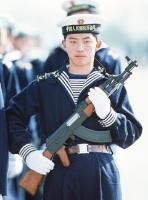In late October, U.S.S. Kearsarge, a 40,000-ton amphibious assault ship, arrived off the coast of Trinidad and Tobago laden with hundreds of doctors, nurses and engineers, and tons of medical supplies. The tiny developing country was the fifth stop in Kearsarge's four-month tour of Latin America, advancing a new Pentagon strategy for creating security through good deeds. Secretary of Defense Robert Gates calls it "soft power" -- and it's all the rage in a military exhausted by five years of hard combat.
The Navy's three-dozen amphibious ships, with their extensive medical facilities, along with its two specialized hospital ships, are at the forefront of this soft-power strategy, delivering humanitarian workers across Latin America, Africa and Southeast Asia. What's more, the Navy is drafting a study reportedly calling for a 20 percent increase in the size of the amphibious fleet, partly to boost these soft-power missions.
Meanwhile, on the other side of the world, at the same time that Kearsarge was steaming towards Trinidad and Tobago, the Chinese navy was building its own fleet capable of soft-power "projection." In October, the People's Liberation Army Navy accepted its first purpose-built hospital ship, the 10,000-ton "Ship 866," fitted with "comprehensive functions and facilities equivalent to level-three class-A hospitals," according to People's Daily. Ship 866 joined the fleet just three months after the acceptance of the first of six 14,000-ton Type 071 amphibious assault ships, themselves fitted with surgical bays.

